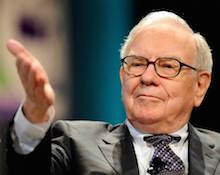Making the case for world equity index trackers is former hedge fund manager turned author Lars Kroijer, an occasional contributor to Monevator. His book, Investing Demystified, is focused on index fund investing.
I believe the only equity exposure you should buy is the broadest, cheapest, and most tax efficient – which is a total world equity index tracker.
Most Monevator readers are probably already willing to accept the following points, which in my view will massively improve your returns over time:
1. You accept that like most investors you don’t have an ability to outperform the financial markets (a so-called ‘edge’) and as a result you agree that you should invest in index tracking products. In other words you’re what I call a ‘rational investor’.
2. You agree that keeping trading to a minimum and investing tax efficiently with the lowest fees will boost your returns in the long run.
3. You accept that to have a hope of decent long-term returns you should have some equity exposure, as the dull returns that safer bonds or cash in the bank provide (which may not currently even beat inflation) mean those assets are very unlikely to do the job alone.
So having agreed to all that, the question is which equities should you own?
Investing without edge
From the perspective of the rational investor – an investor accepting and embracing the fact they don’t have an edge in the market – each dollar, pound, or euro invested in the various stock markets around the world is presumed to be equally smart.
If the markets say a share in Apple is worth $125 and a share in Microsoft is worth $40, then we as rational investors don’t have a preference for owning one of those shares over the other, at those prices.
If we did have a preference, then we would effectively be saying that we know more about the future movements in share prices than the aggregate market does.
As rational investors, we don’t believe that’s true.
We believe that the money/person buying Apple is no more or less clever or informed than the money that’s invested in Microsoft.
And so we follow the money.
The case for market capitalisation weighting
Extrapolating this logic to the whole market means we should own shares in all the market’s stocks, weighted according to their fraction of the overall value of the market.
Let’s assume for a moment that ‘the market’ refers only to the US stock market, and that right now Apple shares represent 3.5% of the total US market value.
This implies that 3.5% of our US equity holdings should be in Apple shares.
If we do anything other than this, then we are effectively saying that we are cleverer or more informed than we really are – that we have an edge over the other investors in the market.
But we don’t believe that’s true.
So 3.5% in Apple it is.
Follow the global money trail
Buying hundreds of shares in a stock market in proportion to their overall market capitalizations is much simpler today than it was even a generation ago.
It is pretty much what most index tracking products offer, assuming they are so-called market capitalisation trackers. (There are other sorts of trackers, which I believe we should reject as rational investors. I’ll explain more in a future article).
In our example above, Apple would constitute 3.5% of the value of a US index tracker.
But why stop at the US market?
There is no reason to think that the UK market is any less informed or efficient than the US one, for instance.
So if there is $15 trillion dollars invested in the US stock market and $2 trillion invested in the UK market, that’s what our portfolio should mirror if we’re to track each dollar, pound, or euro of global capital.
Likewise with any other market in the world investors can get access to.
We should invest in them all, in proportion to their share of the world equity markets, as best we can in practical terms.
No home advantage
Some of you may be nervously twitching at this point. You know you’ve got a lot more money in the UK stock market than in other markets around the world.
This is illogical for rational investors, although it is not unusual.
Many investors around the world overweight their ‘home’ equities.
For instance, the UK represents less than 3% of the world equity markets, but the proportion of UK equities in a typical UK investor’s portfolio is often 40% or more.
Why does this happen?
Investors feel they know and understand their home market. And perhaps active investors think they would be better able to spot opportunities before the wider market at home. (A fanciful notion for us rational investors!)
In fairness, the concentration in home equities can also be because of investment restrictions or perhaps because investors wrongly are matching their investment with liabilities connected to the local market.
Another factor that’s cited is currency risk.
While I think there is some merit in currency matching specific and perhaps shorter-term liabilities via your investment portfolio, I think such matching is better done through the purchase of government bonds in your home currency.
If you worry that major currencies fluctuate too much for you, then I would ask if you’re taking too much equity market risk in the first place?
Broader investment and currency exposure is in my view favourable not only from an additional diversifying perspective, but also as a protection against bad things happening in your home country.
Typically whenever a currency has been an outlier against a broad basket of currencies, it has been a poorly performing one because of problems in that country (though there are exceptions to this rule of thumb).
And it is exactly in those cases that the protection of diversified geographic exposure is of greatest benefit to you. ((Currency hedged investment products do exist, but in my view their on-going hedging expense adds significant costs without clear benefits, and on occasion further fails to provide an accurate hedge. Besides, many companies have hedging programs themselves meaning that a market may already be partially protected against currency moves, or have natural hedges via ownership of assets or operations that trade in foreign currency (like Petrobras owning oil trading in USD).))
Whatever the reason, various studies have suggested that this supposed home field investment portfolio advantage is not real, but many of us still continue to allow our portfolios to be dominated by our home market.
If you are overweight or underweight one country compared to its fraction of the world equity markets, then you are effectively saying that a dollar invested in the underweight country is less clever/informed than a dollar invested in the country that you allocate more to.
You would therefore be claiming to see an advantage from allocating differently from how the multi-trillion dollar international financial markets have allocated.
But you are not in a position to do that unless you have edge.
And we agreed we don’t have edge…
Since the millions of investors who make up the global markets have already moved capital between various international markets efficiently, the international equity portfolio is the best one for anyone without edge.
That’s on top of the other advantages of added diversification, simplicity, and cost.
Do you know better than all the world’s other investors?
Take me as an example. As a Danish citizen who has lived in the US and UK for more than 20 years, I might instinctively over-allocate to the US and Europe because I am more familiar with those markets than, say, Thailand or Japan.
But in doing that I would implicitly be claiming that Europe and the US would have a better risk/return profile than the rest of the world.
It might or might not turn out that way, but the point is that we rational investors don’t know ahead of time.
Similarly, you’ll often hear investors say things like: “I believe Brazil, Russia, India, and China are set to dominate growth over the next decades and are cheap”.
Perhaps you’d be right to say so, but you would also be saying that you know something the rest of the world has not yet discovered.
This is not possible unless you have edge.
Rational investors who accept they don’t have edge should therefore simply buy the global equity market.
The advantage of diversification
The world equity portfolio is the most diversified equity portfolio we can find.
And the benefits of diversification are great.
Consider the following chart showing how diversification impacts risk in a home market, such as the UK stock market:

As you can see from the chart, the additional risk reducing benefit of diversification tails off as we add ever more securities to a home market portfolio.
This makes sense. Shares trading in the same market will tend to correlate, since they are exposed to the same economy, legal system, and so on.
This means that after picking a relatively small number, you have diversified away a great deal of the market risk of holding any individual company.
But by further expanding our portfolio beyond the home market we can achieve much greater diversification in our investments.
This is not just because we spread our investments over a larger number of stocks, but more importantly because those stocks are based in different geographies and economies. ((I believe this is still true, despite international correlations having gone up as the world has become more inter-related and large companies increasingly global.))
So we could have similar chart to the one above, but one where “securities” was replaced with “countries” in the x-axis.
Only a few decades ago, we did not have the opportunity to invest easily across the world like this.
But with the range of index funds and ETFs now available, investing in a geographically diversified way is a lot easier than it used to be.
One fund to do it all
In fact today you can invest across the global equity market by putting your all your equity money into a single world equity tracking fund or ETF.
To summarize the benefits:
- Your portfolio will be as diversified as possible and each dollar invested in the market is presumed equally clever; consistent with what a rational investor believes. (I bet a lot of Japanese investors wished they had diversified geographically after their domestic market declined as much as 75% from its peak during the past 20 years.)
- Since we are simply buying ‘the market’ as broadly as we can, it’s a very simple portfolio to construct and thus very cheap to run – and of course we don’t have to pay anyone to be smart about beating the market. Over time this cost benefit can make a huge difference. Don’t ignore it!
- This kind of broad based portfolio is now available to most investors, whereas only a couple of decades ago it was not. (Most people then thought ‘the market’ meant only their domestic market.)
Even if you are already an index tracking investor, for some of you getting an internationally diversified portfolio may have involved combining multiple products in a bit of an ad hoc way to gain international exposure (perhaps based on gut feel of which markets will outperform).
Don’t bother. The market has already done all the work of allocating between countries and regions for you.
Instead, focus only on how much you want in equities overall compared to less risky asset classes and on collecting the equity premium.
The bottom line is you should buy the broadest based index tracking products you can.
By definition, that’s a total world equity market tracker.
Lars Kroijer’s book Investing Demystified is available from Amazon. He is donating all his profits from his book to medical research. He also wrote Confessions of a Hedge Fund Manager.






